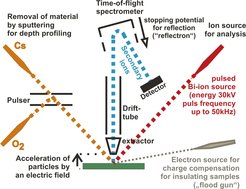
TOF-SIMS (Time-of-Flight Secondary Ion Mass Spectrometry)
- Secondary electron microscopy (SEM): lateral resolution <40 nm.
- Determines the chemical composition (spatially-resolved): ppm-ppb sensitivity.
- Spatially-resolved Mass Spectrometry: lateral resolution <50 nm; depth resolution <1 nm.
- Parallel mass detection up to high masses (>12000 u).
- Mass resolution up to 12000.
- Cold sample transfer for volatile materials.
- Transfer of samples from glove box under Ar or N2 atmosphere without air exposure.
- Sample cooling to 120 K and heating to 870 K.
- Charge Neutralization: ideal for insulators.
- In combination with an Atomic Force Microscope (AFM) the sputter profile can be directly imaged for depth profiling.
- Focused ion beam (gallium) option for cross sectional chemical imaging.
- Gas Cluster Ion Source for sputtering with Ar or O with 500-5000 Cluster size is available for stoichiometric sputtering of organic samples.
- Some possible applications: Defect chemistry, Transport of oxygen in ionic materials, Reactions at interfaces, Composition of Quantum dots and their interfaces, Multilayer Structures (how sharp are the interfaces?), Proton Conductors, Nano Electronics, Nano Fibers, Clusters, Oxides, Nitrides, Hydrides, HTc superconductors, battery materials, composition of molecular monolayers.

A short pulse of Bi-ions bombards the specimen and sputters it. This produces a cloud of atoms and molecules with some of them beeing ionized. The ionized particles of one polarity – atomic and molecular secondary ions – are accelerated into a reflection type time-of-flight mass spectrometer. They travel through a tube to arrive at an ion detection and counting system. Because all ions depart from the sample at the same time and were subject to the same accelerating voltage, the lighter ones arrive at the detection system before the heavier ones, which leads to a mass selection.
The next pulse of primary ions cannot start until the secondary ions of the first pulse have cleared the analyzer. Otherwise the slower heavy ions of the first pulse are overtaken by the faster light ions of the second pulse. However the time interval between consecutive pulses can be used for other activities, such as sputtering and charge neutralization.
Ion images are produced by scanning the primary beam over the sample surface and recording the number of ions as a function of the position. The images of all the ions are detected in parallel. The bombarding ions also produce secondary electrons, which can be detected to give secondary electron images. The spatial resolution of the images depends largely upon the diameter of the pulse of primary ions. The ion image resolution is better than 50 nm and the secondary electron image resolution better than 40 nm.
The sputtering of all the secondary ions should happen simultaneously so that the spectral resolution is not degraded. This requires the primary ion pulse to be as short as possible. Pulsing is achieved by rapid deflection of the primary ion beam, and a device called a buncher is introduced into the primary ion column, compressing the pulse duration to less than 1 ns.
The ToF analyzer is vertically mounted. The extracted ions travel upwards to an ion mirror where they are reflected downwards to the detection system. This allows for easy compensation of the energy spread of the sputtered species (time focusing). The detection system is a combination of a channel plate, scintillator and photomultiplier, combined with a very fast electronic counting system.
